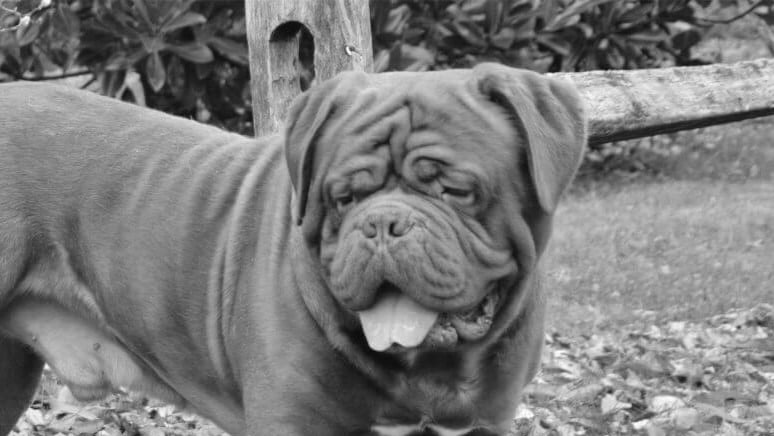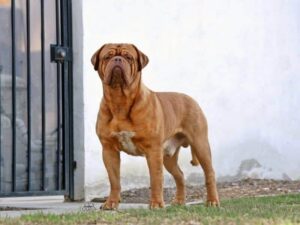
Affectionate, Loyal, Courageous: Dogue de Bordeaux
The most ancient of French dog breeds, the Dogue de Bordeaux, also known as the Bordeaux Mastiff, is a very powerful mastiff-type guard dog.
Home » Meet The Breeds » Dogue de Bordeaux
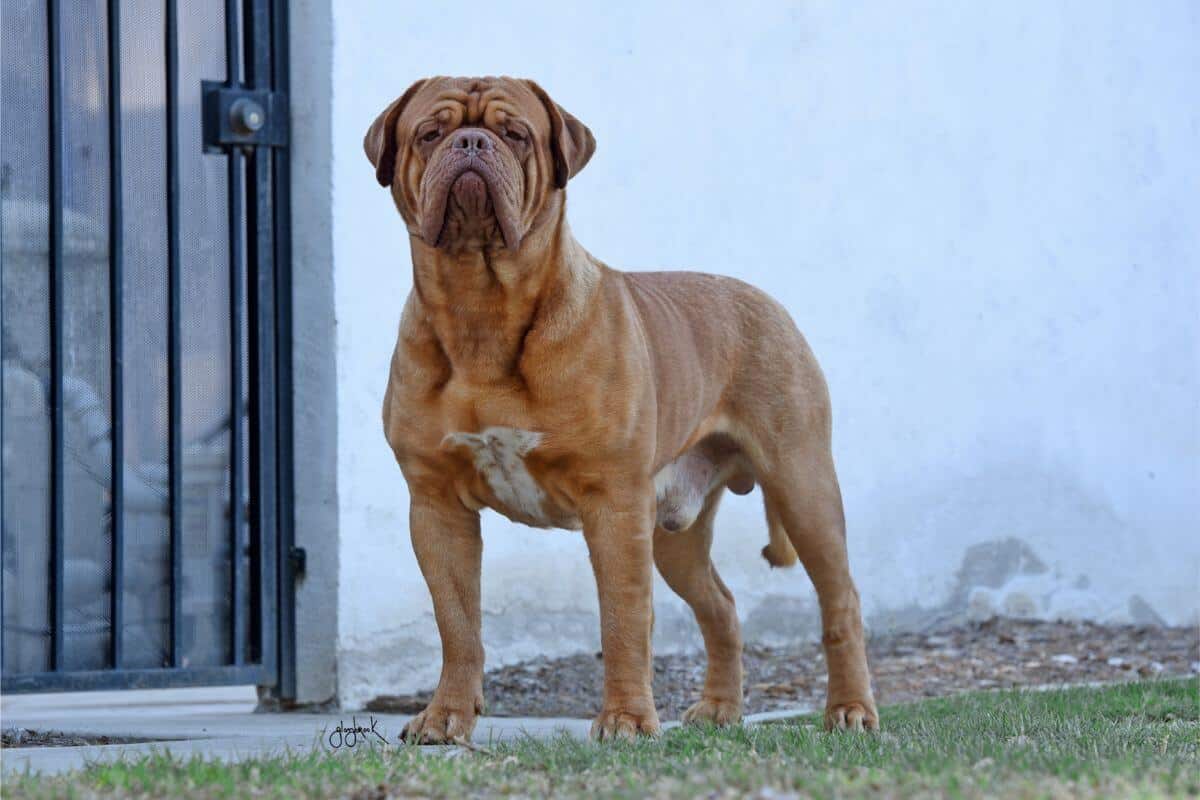
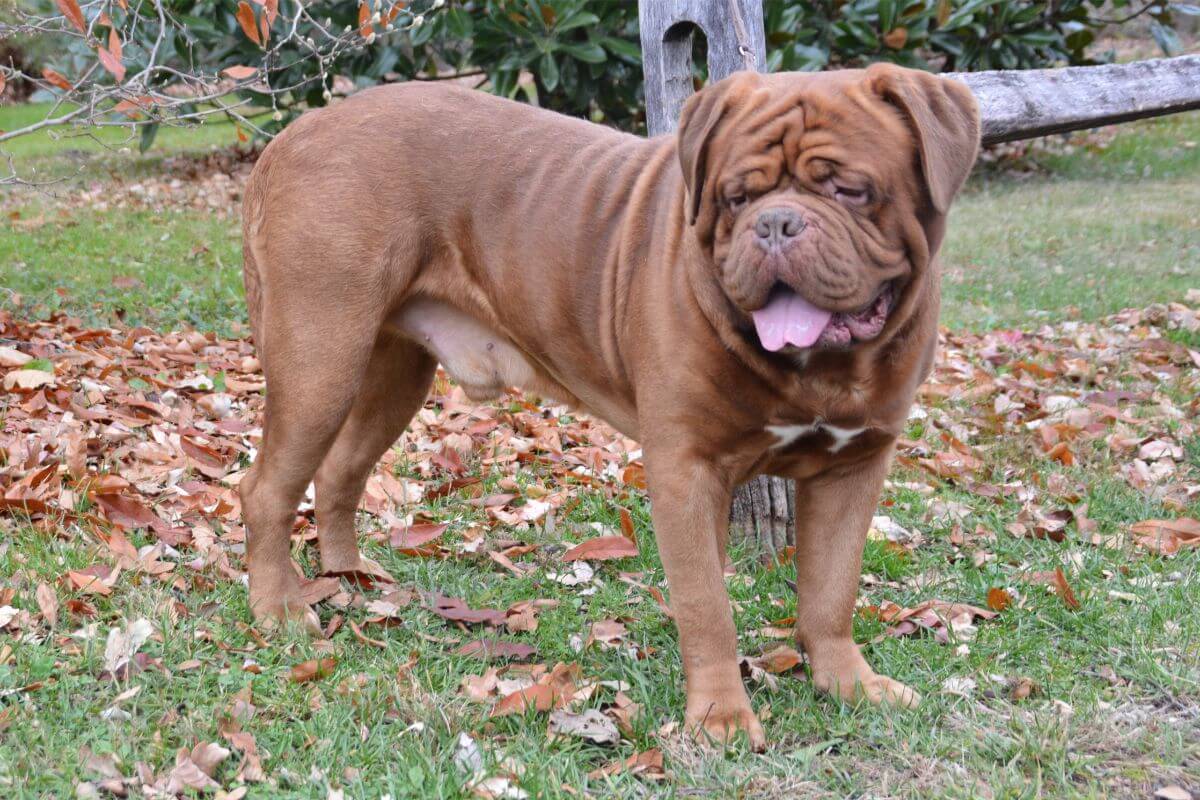
The Dogue de Bordeaux, also known as the French Mastiff, is one of the oldest French breeds of dog. Known for its muscular build and protective nature, the breed has been used historically as an imposing guardian, a big game hunter, and a reliable working dog.
Working
23 – 27 inches
99 – 110 pounds & up
5 – 8 years
| Country of Origin | France |
|---|---|
| Bred For | Guarding |
| Known For | Massive Head, Stocky & Athletic Build, Self-Assurance |
| Popularity | Moderate |
| Temperament | Calm, Companionable, Courageous |
| Activities | Guarding, Conformation Shows, Dog Sports |
The Dogue de Bordeaux has a history that dates back to ancient Gaul, where it is believed to have descended from molossers and mastiff-type dogs brought to Europe by the Romans. The breed was primarily developed in the Bordeaux region of France, where it served as a versatile working dog.
Historically, Dogues were used for guarding estates, pulling carts, and even hunting large game such as wild boar. By the Middle Ages, they were prized as powerful protectors, often used by the French nobility to guard castles and estates. The breed’s strength and loyalty made it indispensable for both labor and protection.
The Dogue de Bordeaux was first officially recognized in France in 1863 when the breed was exhibited at the first French dog show in Paris. During the 19th century, the breed faced challenges due to changing societal roles and had nearly become extinct by the mid-20th century. Efforts by dedicated breeders helped to revive the breed, with official recognition by the Fédération Cynologique Internationale (FCI) granted in 1954.
In the United States, the Dogue de Bordeaux gained popularity after the breed appeared prominently in the 1989 film Turner & Hooch. The American Kennel Club (AKC) granted full recognition to the breed in 2008, placing it in the Working Group.
Dogue de Bordeaux males typically stand between 23.5 and 27 inches tall at the shoulder, while females measure from 23 to 26 inches. Adult males generally weigh 110 pounds or more, while mature females weigh at least 99 pounds.
The athletic Dogue de Bordeaux is a massive breed with a powerful and muscular build that appears “rather close to the ground.” The breed’s proportions reflect its strength and endurance, with a near-level topline and a back and loin that appear broad when viewed from above.
Texture: The Dogue de Bordeaux has a short, fine, coat that is soft and lies close to the body. The skin is thick and sufficiently loose-fitting without excessive wrinkles. A well-defined dewlap, from the throat forming folds to the chest, hangs without exaggeration.
| Standard Color | |
|---|---|
| Fawn | y |
| Mahogany/td> | y |
| Isabella | y |
| Red | y |
| Standard Marking | |
|---|---|
| White Patches | y |
| Black Mask | y |
| Brown Mask | y |
| Black Mask, White Markings | y |
A Note About Color: The Dogue de Bordeaux is a self-colored dog in rich shades of fawn, from dark red fawn to a light fawn. Any other color is not allowed. Individual patches of white are allowable on the forechest (a secondary patch on the throat is acceptable but not preferred), toes (not above the pastern and hock joints), and on the backs of the pasterns. A black mask, if present, spreads out only slightly and does not appear on the skull.
The tail of the Dogue de Bordeaux is very thick at the base and tapers to a point. It is carried low when the dog is relaxed but is carried level with the back, or slightly above, when the dog is active or alert. The tail is natural and not docked, and should not be kinked, knotted, atrophied, or laterally deviated or twisted.
The Dogue de Bordeaux requires a commitment to meeting the needs of this large, loyal, and powerful breed. Prospective owners should be prepared to provide proper training and exercise, and a safe and secure environment to encourage the development of a well-rounded and well-behaved companion.
The Dogue de Bordeaux typically has a lifespan of 5 to 8 years, which is shorter than many dogs due to the breed’s large size and predisposition to certain health conditions. While generally resilient, the Dogue benefits from regular veterinary care, a balanced diet, and a healthy lifestyle to maintain its quality of life.
The Dogue de Bordeaux can be prone to several health issues, including:
The Dogue de Bordeaux is a loyal, affectionate, and calm breed that forms a deep bond with its family members. While known for its gentle demeanor with children, the breed’s protective instincts make it naturally wary of strangers, requiring early and consistent socialization.
Dogues thrive in homes where they are included in family activities and given plenty of attention, as they can become lonely or anxious if left alone for extended periods. Although generally good with other dogs when properly introduced, their strong personalities may lead to assertive behaviors, especially with unfamiliar animals.
The Dogue de Bordeaux requires a high-quality, well-balanced diet tailored to its large size and slower metabolism. Puppies should be fed a large-breed puppy formula to support rapid growth while minimizing stress on the developing joints.
Adult Dogues typically require 4 to 7 cups of food per day, divided into two meals, depending on size, age, and activity level. Access to fresh water is essential, and feeding schedules should be consistent to avoid issues like bloat. Caretakers should avoid overfeeding, as the breed can be prone to obesity, which will exacerbate other health concerns.
The Dogue de Bordeaux is an intelligent breed but can be stubborn, requiring firm yet patient training. Early obedience training and socialization are crucial to manage its protective instincts and ensure it is comfortable around people and other animals.
Positive reinforcement methods, such as treats and praise, work best, as harsh techniques can damage trust and hinder progress. While not overly energetic, the breed benefits from participation in activities that are mentally stimulating. With consistent leadership, the Dogue can become a well-mannered and devoted companion.
The Dogue de Bordeaux has moderate exercise needs, requiring at least 30 to 60 minutes of daily activity to maintain its health and prevent boredom. This can include leisurely walks, playtime in a secure yard, or interactive games like tug-of-war.
| Energy Level | Moderate |
|---|---|
| Exercise Requirements | 1 Hour/Day (Minimum), Daily Walks, Vigorous Running, Regular Exercise, Mental Stimulation |
While this is not a high-energy breed, regular exercise is crucial to prevent obesity and strengthen muscles. However, care should be taken to avoid overexertion, especially during hot weather, as the breed is prone to overheating due to its size and short muzzle.
The Dogue de Bordeaux has minimal grooming needs due to its short, smooth coat. Weekly brushing with a soft-bristle brush or grooming glove helps to remove loose hair and maintain a healthy coat.
| Coat Type | Fine, Short, Soft |
|---|---|
| Grooming Requirements | Weekly Brushing, Occasional Bathing, Routine Ear Cleaning, Periodic Nail Trimming, Regular Tooth Brushing |
Special attention should be given to the breed’s facial wrinkles, which need to be cleaned and dried regularly to prevent infections. Routine grooming also includes trimming nails, cleaning ears, and brushing teeth to ensure overall health and good hygiene.
The Dogue de Bordeaux is best suited for homes with a securely fenced yard and enough space to accommodate its large size. While these dogs can adapt to apartment living, their size and strength make a more spacious environment the ideal.
Dogues are sensitive to extreme temperatures and should be kept indoors during hot or cold weather. They are deeply devoted to their families and thrive when included in daily activities, making them excellent companions for households that can meet their breed-specific needs for attention and care.
Dogue de Bordeaux puppies are affectionate, curious, and quick learners, but their large size and strong personalities require thoughtful support and guidance. Rapid growth during the first year necessitates proper nutrition and care to promote healthy development and minimize joint issues later in life.
Caring for a Dogue de Bordeaux puppy starts with creating a safe, structured environment and setting clear boundaries. Puppy-proofing the home is essential, as the pup’s curiosity and size can lead to accidents or the destruction of cherished household items.
Early socialization is critical to prevent fearfulness or excessive guarding instincts. Introducing the puppy to various people, animals, and environments helps to develop confidence and nurture a calm temperament.
Feeding a high-quality large-breed puppy formula promotes proper growth and supports healthy joints. Meals should be divided into three to four smaller portions daily, transitioning to two meals as the pup matures.
Training should begin early and focus on basic commands and housebreaking, and introducing a crate as a place to comfortably rest and sleep. Positive reinforcement methods, such as treats and praise, work best for this powerful yet companionable breed. Routine veterinary care and support from the puppy’s breeder are vital to monitor growth during this critical period.
With proper care and guidance, the Dogue de Bordeaux puppy will grow into a devoted, protective, and loving family member.
The Dogue de Bordeaux is recognized by the world’s leading registries and kennel organizations, which categorize the breed into a specific Group based on its unique characteristics. This breed is recognized worldwide under the following Group designations:
| Organization | Group Designation |
|---|---|
| AKC (American Kennel Club) | Working |
| UKC (United Kennel Club) | Guardian |
| CKC (Canadian Kennel Club) | Working |
| ANKC (Australian National Kennel Council) | Utility |
| RKC (The Royal Kennel Club) | Working |
| FCI (Fédération Cynologique Internationale) | Group 2: Pinscher and Schnauzer Molossoid Breeds – Swiss Mountain and Cattle Dogs; Section 2.1: Molossoid Breeds |
The ideal Dogue de Bordeaux is described by a Breed Standard that is approved by each of the world’s leading registries and kennel organizations. The Breed Standards for this breed may be found in the following links:
| Organization | Breed Standard |
|---|---|
| American Kennel Club | AKC Dogue de Bordeaux Breed Standard |
| United Kennel Club | UKC Dogue de Bordeaux Breed Standard |
| Canadian Kennel Club | CKC Dogue de Bordeaux Breed Standard |
| Australian National Kennel Council | ANKC Dogue de Bordeaux Breed Standard |
| The Royal Kennel Club | RKC Dogue de Bordeaux Breed Standard |
| Fédération Cynologique Internationale | FCI Dogue de Bordeaux Breed Standard |
Yes, Dogue de Bordeaux shed. Regular weekly brushing helps to manage any loose hair and maintain the coat’s healthy appearance.
No, Dogue de Bordeaux are not hypoallergenic. They shed hair and produce dander, which can trigger allergies in sensitive individuals.
Dogue de Bordeaux typically live between 5 to 8 years. Their lifespan is shorter than many breeds due to their large size and a predisposition for certain health issues.
Yes, Dogue de Bordeaux are excellent family dogs, known for their loyalty and calm demeanor. They are affectionate with their families and gentle with children when properly socialized and trained.
No, Dogue de Bordeaux are not excessive barkers. They tend to bark only when necessary, such as to alert their owners to potential visitors, staying true to their guarding instincts.

The most ancient of French dog breeds, the Dogue de Bordeaux, also known as the Bordeaux Mastiff, is a very powerful mastiff-type guard dog.
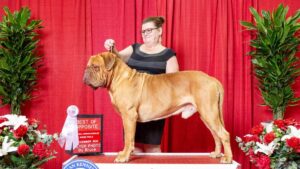
Stephanie Friedley of Amore Kennel shares her journey in Dogues de Bordeaux, focusing on soundness, type, and breed education.
The best way to ensure a long and happy relationship with a purebred dog is to purchase one from a responsible breeder. Not sure where to begin?
Contact the National Parent Club’s Breeder Referral Program, which is listed on the AKC Breeder Referral Contacts page.
